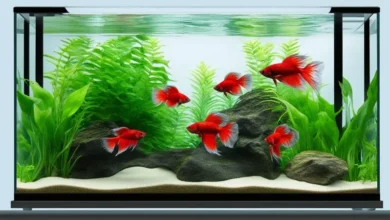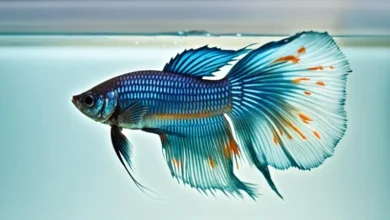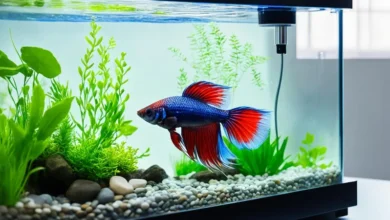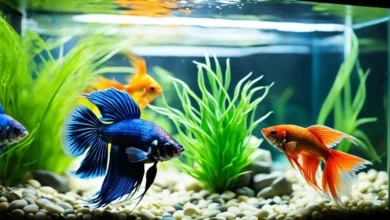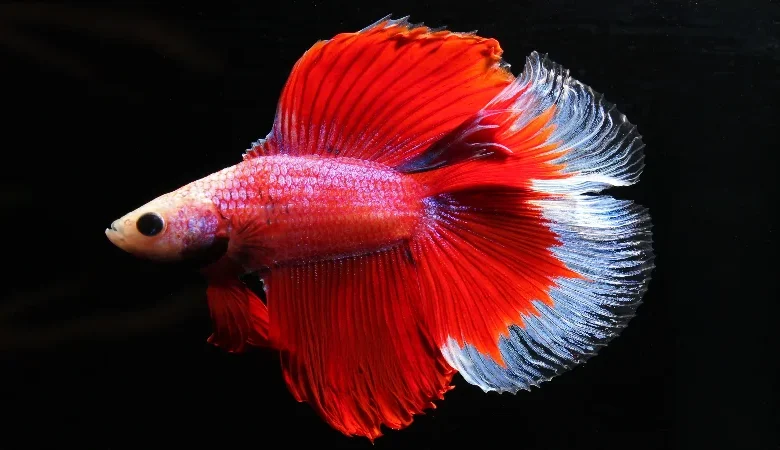
Have you ever been mesmerized by the elegant double-lobed tail of a Double Tail Betta fish gracefully flowing through the water? These stunning aquatic jewels have captured the hearts of aquarium enthusiasts worldwide. However, their unique genetics and physical characteristics require special attention and care to ensure they thrive.
In this comprehensive guide, we’ll dive deep into everything you need to know about Double Tail Betta Care, from tank setup to troubleshooting common health issues. Whether you’re a first-time betta keeper or an experienced aquarist looking to add this spectacular variety to your collection, this guide will equip you with the knowledge to provide your Double Tail Betta fish with the best possible care.
What Makes Double Tail Bettas Special?
Before we delve into care specifics, let’s understand what makes these fish unique. Double Tail Bettas (often abbreviated as DT) are characterized by their two distinct tail lobes of approximately equal size, created by a genetic mutation that splits their caudal fin.
This mutation affects more than just their appearance—it often results in a broader body and shorter length compared to standard bettas, which can impact their swimming ability and overall care requirements.
Tank Setup: Creating the Perfect Home
Tank Size
While many pet stores might suggest small bowls, Double Tail Bettas require proper space to thrive:
| Tank Size | Suitability | Notes |
|---|---|---|
| Under 2.5 gallons | Not recommended | Difficult to maintain stable water parameters |
| 5 gallons | Minimum recommendation | Easier maintenance, more swimming space |
| 10+ gallons | Ideal | Best for long-term health, potential community setup |
Double Tail Bettas particularly benefit from horizontal swimming space due to their heavier fins. A 5-gallon tank should be considered the absolute minimum, with 10 gallons providing a much better environment.
Filtration
A gentle filtration system is essential for Double Tail Betta care. Their split tails create more drag, making strong currents particularly challenging for them to navigate.
- Sponge filters: Excellent low-flow option that provides both mechanical and biological filtration
- Adjustable HOB filters: Look for models with flow control
- Baffle options: Use aquarium sponges or DIY baffles to reduce flow if needed
Remember: Your betta should be able to swim without being pushed around by the current.
Heating
Being tropical fish, Double Tail Bettas require consistent warm temperatures:
- Temperature range: 78-80°F (25.5-26.7°C) is optimal
- Heater type: Always choose an adjustable heater rated for your tank size
- Heater placement: Position away from areas your betta may rest to prevent burns
- Thermometer: Digital thermometers provide the most accurate readings
Temperature stability is crucial—fluctuations can stress your betta and compromise your immune system.
Lighting
A proper lighting schedule helps maintain your betta’s natural biological rhythms:
- 8-10 hours of light daily
- Avoid direct sunlight (causes temperature fluctuations and algae growth)
- Consider a simple timer to automate lighting
- If using live plants, choose an appropriate spectrum of light
Substrate
Several options work well for Double Tail Betta tanks:
- Sand: Natural appearance, easy to clean, won’t damage delicate fins
- Small smooth gravel: Ensure pieces aren’t sharp or large enough to trap food
- Bare bottom: Easiest to clean but less natural looking
Decorations
When selecting decorations, prioritize safety for those delicate double tails:
- Inspect all items for sharp edges or rough surfaces
- Provide hiding places like smooth caves or dense plants
- Avoid plastic plants that can tear fins—opt for silk or live plants instead
- Include resting spots near the surface—betta hammocks or broad-leaved plants work well
Pro tip: The “pantyhose test” helps identify fin-safe decorations—if an item snags pantyhose, it will likely damage your betta’s fins.
Water Parameters: The Foundation of Health
Maintaining proper water chemistry is critical for Double Tail Betta care. These parameters should be regularly tested with a reliable test kit:
| Parameter | Ideal Range | Critical Information |
|---|---|---|
| Temperature | 78-80°F (25.5-26.7°C) | Use an adjustable heater |
| pH | 6.8-7.5 | Stability matters more than exact number |
| Ammonia | 0 ppm | Toxic at any detectable level |
| Nitrite | 0 ppm | Toxic at any detectable level |
| Nitrate | Below 20 ppm | Reduce through water changes |
| GH (General Hardness) | 3-6 dGH | Affects osmotic regulation |
| KH (Carbonate Hardness) | 4-8 dKH | Helps stabilize pH |
Water Conditioning
Always treat tap water with a quality water conditioner that:
- Neutralizes chlorine and chloramine
- Detoxifies heavy metals
- Ideally provides a protective slime coat
Feeding: Nutrition for Vibrant Health
Double Tail Bettas are carnivores that require a protein-rich diet to maintain their vibrant colors and overall health.
Recommended Foods
- High-quality betta pellets: The foundation of their diet (look for crude protein >40%)
- Frozen foods: Bloodworms, daphnia, brine shrimp (excellent nutritional value)
- Live foods: Mosquito larvae, daphnia (provides enrichment and nutrition)
- Freeze-dried options: Convenient but should be soaked before feeding
Feeding Schedule
- Frequency: 1-2 times daily
- Portion size: 2-3 pellets per feeding (stomach size of an eyeball)
- Fasting: Consider one fasting day per week to prevent bloating
Double Tail Betta fish are especially prone to swim bladder issues due to their body shape, making proper portion control essential to prevent bloating and constipation.
Water Changes: Maintaining Pristine Conditions
Regular water changes are the cornerstone of Double Tail Betta care. Their split tails are more susceptible to fin deterioration in poor water conditions.
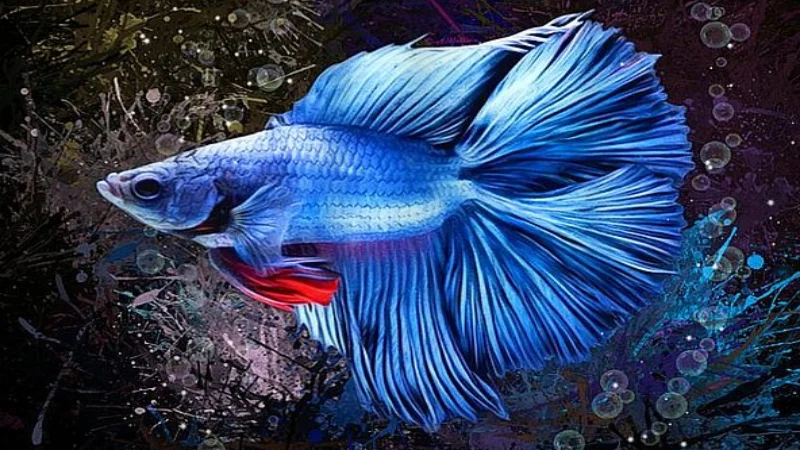
Water Change Schedule
| Tank Size | Frequency | Amount |
|---|---|---|
| 5 gallons | Weekly | 25-30% |
| 10 gallons | Weekly | 20-25% |
| 10+ gallons | Weekly | 15-20% |
Water Change Procedure
- Prepare new water a day in advance (allows chlorine to dissipate)
- Match temperature closely to tank water (±2°F maximum)
- Use a gravel vacuum to remove waste from the substrate
- Add water conditioner to the new water
- Pour gently to avoid stressing your betta
Important: Never do 100% water changes—this disrupts beneficial bacteria and causes stress.
Tank Mates: Choosing Compatible Companions
Double Tail Bettas have specific temperaments that must be considered when selecting tank mates. Their reduced swimming efficiency due to their heavy tails makes them vulnerable to being outcompeted for food.
Suitable Tank Mates
- Snails: Nerite, Mystery, or Malaysian Trumpet snails
- Shrimp: Amano or Ghost shrimp (with caution and hiding places)
- Small peaceful fish: Ember tetras, Harlequin rasboras (in 10+ gallon tanks)
- Pygmy corydoras: Peaceful bottom dwellers
Unsuitable Tank Mates
- Fin nippers: Tiger barbs, serpae tetras
- Fast, flashy fish: Guppies (trigger aggression)
- Other bettas: Will fight regardless of gender
- Large or aggressive species: Cichlids, most gouramis
When introducing any tank mates, carefully monitor interactions for the first few weeks.
Planting Your Betta Tank: Benefits Beyond Beauty
Live plants provide tremendous benefits for Double Tail Betta fish:
- Natural water filtration
- Resting places for heavy-finned bettas
- Security and stress reduction
- Oxygenation of water
- Nitrate reduction
Recommended Plants for Betta Tanks
- Anubias: Low-light, attaches to hardscape, broad leaves for resting
- Java fern: Nearly indestructible, doesn’t require a substrate
- Amazon sword: Larger tanks only, provides excellent coverage
- Marimo moss balls: Decorative, help with water quality
- Water wisteria: Fast-growing, helps with nutrient absorption
- Java moss: Provides foraging opportunities and hiding spots
Plant care tip: Most betta-friendly plants are low-light species that don’t require CO2 supplementation or specialized substrates.
Troubleshooting Common Problems
Even with excellent Double Tail Betta care, health issues may occasionally arise. Prompt identification and treatment are essential.
Fin Rot
Symptoms:
- Ragged or deteriorating fins
- Black or red edges on fins
- Fin bases becoming inflamed
Solutions:
- Improve water quality immediately (25-30% water change)
- Test for ammonia and nitrite spikes
- Consider an antibacterial medication if severe
- Aquarium salt treatments (1 tbsp per 5 gallons) can help mild cases
Ich (White Spot Disease)
Symptoms:
- White dots resembling salt grains on the body and fins
- Scratching against objects
- Increased gill movement or respiratory distress
Solutions:
- Gradually increase temperature to 86°F (30°C) for 10-14 days
- Medication specifically for this treatment
- Maintain excellent water quality throughout the treatment
Swim Bladder Disease
Double Tail Bettas are particularly susceptible to swim bladder issues due to their compressed body shape.
Symptoms:
- Difficulty maintaining position in water
- Floating sideways or upside down
- Sinking to the bottom despite efforts to swim
Solutions:
- Fast for 2-3 days
- Offer daphnia (natural laxative)
- Ensure the temperature is at optimal range (78-80°F)
- Consider Epsom salt bath (1 tbsp per gallon) in a separate container
Long-Term Care Considerations
The Double Tail Betta lifespan typically ranges from 2-4 years with proper care. Their genetic mutation can sometimes lead to shorter lifespans compared to other betta varieties, making proper care even more crucial.
Seasonal Considerations
- Summer: Guard against overheating—tank temperatures should not exceed 82°F
- Winter: Protect against drafty windows that can cause temperature fluctuations
- Power outages: Have battery-operated air pumps available for emergencies
Double Tail vs. Halfmoon Betta: Understanding the Differences
While sometimes confused, these varieties have distinct characteristics:
| Feature | Double Tail Betta | Halfmoon Betta |
|---|---|---|
| Caudal fin | Two distinct lobes | Single tail spread 180° |
| Body shape | Often broader, shorter | Standard betta shape |
| Swimming ability | May be less efficient | Typically stronger swimmer |
| Special needs | More prone to swim bladder issues | Susceptible to fin tears |
Conclusion
Double Tail Betta care requires attention to detail, but the reward is a magnificent, personable pet with vibrant colors and unique charm. Their distinctive genetic trait that creates those beautiful double tails does come with special care requirements—particularly regarding water quality, tank size, and feeding regimen.
By following this comprehensive guide, you’ll be well-equipped to provide your Double Tail Betta fish with an environment where they can thrive, display their spectacular Double Tail Betta colors, and perhaps even engage in Double Tail Betta breeding if that’s your goal.
Remember that each betta has its personality. Taking the time to observe your fish’s specific behaviors and preferences will help you provide truly individualized care for your aquatic companion.
Have you noticed any unique behaviors or traits in your Double Tail Betta? Share your experiences in the comments below!
